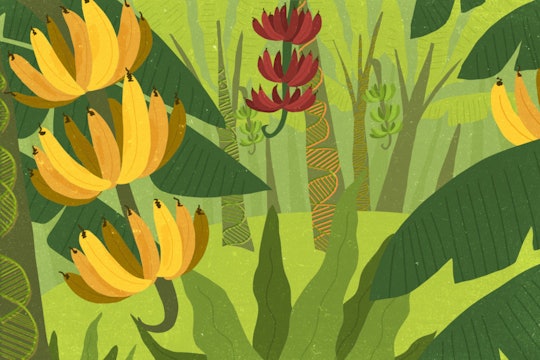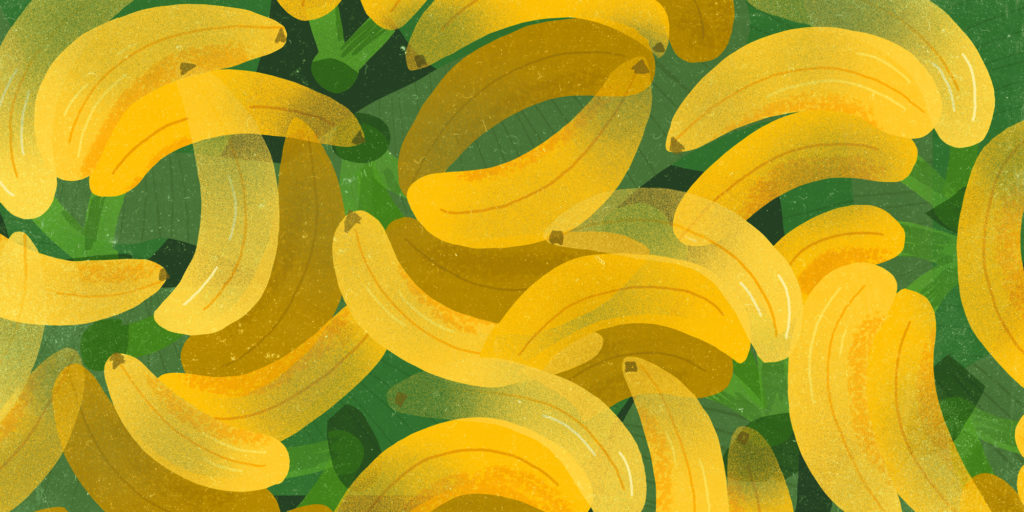

A version of this story originally appeared on Grow
The banana as we know it is going extinct. Could gene editing save it?
How the Cavendish pandemic could pave the way for tastier bananas
The contagion begins its sweep, commuting with workers from farm to farm. It seems like a local problem at first, but eventually crosses borders and oceans to engulf the whole world. This contagion, Fusarium Wilt Tropical Race 4 (TR4), may cause a mass extinction. Luckily this pandemic isn’t coming for us humans. Instead, it is targeting our favorite fruit: TR4 is on course to wipe out the Cavendish banana.
This is significant. Bananas are the most commonly eaten fruit in the world, and 99% of the bananas sold internationally are Cavendish. All together, we humans feast on 80 million tonnes of Cavendish a year, the fruit of some 5 billion tropical trees. The next time you slice a Cavendish onto your cereal or blitz it into a smoothie, savor it while you can. The banana as we know it may soon be history. On the upside, a better, tastier banana may take its place.
The Outbreak
In the early 1990s, farmers in Malaysia and Indonesia started to report that their Cavendish plantations were dying from an unknown pathogen. The disease spread with astonishing speed. First, the leaves of a few plants would wilt and yellow. Within a year, a third of trees would have the disease. A year later, the entire plantation was exterminated.
The culprit was identified eventually: TR4, a fungus living in the soil, persisting there for decades, impervious to chemical sprays. It soon spread to surrounding nations: China, Australia, and the Philippines, before traveling up through Central Asia as far as Turkey, likely hitching a ride on contaminated farm equipment and workers’ boots. In 2013 it reached Africa, where it was discovered on a farm in Mozambique. Last year, it finally hit the motherlode, reaching Latin America — the world’s biggest banana exporter — leading Colombia to declare a “phytosanitary emergency.”
The level of alarm is justified: Cavendish has no resistance to TR4, and farmers have few if any treatments available. At this point, when TR4 attacks a banana crop, the farmer abandons the entire area of land and begins anew on a fresh plot. It’s only a matter of time before there is no clean land left for planting Cavendish bananas.
We know this, because it happened once before. In the mid-20th century, another Fusarium strain, Tropical Race 1 (TR1), attacked the Gros Michel banana, the most popular export banana at the time. TR1 quickly spread around the world, and by the 1960s, banana growers admitted defeat and switched to growing the Cavendish (a half-sibling of the Gros Michel, as both share one parent). While neither as tasty nor robust as the “Big Mike,” it was at least resistant to TR1.
This time, things may turn out differently. Armed with the latest gene editing technology, scientists are racing to design a better banana.
How the Cavendish Conquered the World
There are more than 1000 varieties of banana in cultivation across the tropics, but almost all are destined for local markets and are never enjoyed outside their country of origin. When it comes to selling bananas abroad, a single variety rules supreme. To understand why a global industry came to rely on such a monoculture, it helps to know a bit about the history — and genetics — of bananas.
Bananas were domesticated as much as 7000 years ago when farmers crossed wild bananas such as Musa acuminata and Musa balbisiana. Some of these offspring took two sets of chromosomes from one parent and a third from the other. Where its ancestors had fruit packed with inedible seeds, the domesticated triploid plant often produced bunches of fleshy, seedless fruit perfect for on-the-go consumption. Being seedless, it was also sterile, so new plants could only be grown by taking cuttings from an existing specimen— known as vegetative propagation.
Using this method, one plant can become two, ten, ten million. And that is how, if you live outside the tropics, it’s likely that every single banana you’ve ever eaten is closely related to — or even propagated from — a handful of plants raised in a greenhouse in England in 1834 by William Cavendish, the 6th Duke of Devonshire.
The duke’s banana tree likely originated in China before being carried to Mauritius by ocean-going traders. In 1814, the British took control of the island nation, and the banana tree was one of endless spoils sent back to Britain from its colonial empire. After successfully raising the tree in the greenhouses of Chatsworth House, the specimen was christened Musa cavendishii in the duke’s honour. A cutting found its way to Samoa, in the South Pacific, and from there continued to spread around the world.
In those Genes
Typically, when crops are attacked by disease, some are spared by naturally occurring resistance. Breeders take these survivors and cross them to generate new, hardier strains. But with no genetic variability, there are no Cavendish plants resistant to TR4. And being sterile, there is no way to cross the Cavendish with a different banana variety that is resistant to the pathogen.
Yet, near the town of Humpty Doo in Australia’s Northern Territory, deep green fans of healthy Cavendish trees sway over a field riddled with Fusarium spores. The farm is one of several operated by Banana Biotechnology Program at Queensland University of Technology (QUT).
In 2012, a team led by QUT’s James Dale inserted a gene for TR4 resistance from a wild banana into the Cavendish. “That trial ran for three years, and had four lines, which showed very high resistance,” he says. “Now we’ve planted a much larger trial with new lines and seen exactly the same results. We’ve essentially got Cavendish that are highly resistant or immune to TR4.”
But it’s unlikely that you’ll ever get to taste Dale’s Fusarium-proof bananas. “Genetic modification is always controversial — particularly in Europe,” he says, describing the modified cultivar as a safety net rather than a solution. The introduction of a foreign gene means the Humpty Doo Cavendish would require exhaustive safety testing before it could go on sale. For a banana that won’t get stuck in regulator’s throats, scientists including Dale are trying to coax similar resistance from the Cavendish’s own genetic material.

Illustrations by Swetha Kanithi
“Say, you find a wild banana in Southeast Asia that has resistance gene to Fusarium, then you have two options,” says Hervé Vanderschuren, professor of tropical crop improvement at KU Leuven in Belgium. “You can take this gene and transfer it to Cavendish. Another option is to say, okay, in the Cavendish I see the same gene, but it doesn’t have the right mutations. Let’s manipulate the gene to one that confers resistance,” says Vanderschuren. “It’s a kind of speed evolution.”
His lab is using a precision gene-editing tool CRISPR to edit the Cavendish’s genome. The Belgian university hosts the world’s leading gene bank for bananas, with thousands of varieties in its collection. Because many don’t have seeds that can be stored, they are kept as tiny living plantlets that demand continuous care.
Approaching the problem from the other side, Leena Tripathi is trying to knock out genes from the Cavendish that increase its susceptibility to TR4. “It’s easier to do that than turn on a resistance gene,” she explains. Stationed at the Nairobi branch of the International Institute of Tropical Agriculture, the biotechnologist says the first batch of gene-edited banana trees are currently being wrapped up for delivery. As TR4 is a quarantined pathogen, and not yet present in Kenya, the TR4-resistant plantlets must be sent to labs in affected countries to undergo trials there.
How to Have Your Banana and Eat It Too
Saving the Cavendish is not just a scientific challenge. “It’s not like if you have a resistant banana tomorrow, the whole of Chiquita and Dole are going to sell this,” says Vanderschuren. For one, consumers may bristle at the idea of scientists tinkering with their favourite snack — even if that snack is a sterile, mutant, hyper-monocultured pseudo-fruit.
Any TR4-resistant Cavendish will also have to pass regulators. In 2016, the US Department of Agriculture announced that it would not seek to regulate a mushroom which had been gene-edited with CRISPR to reduce browning, leaving the door open for similarly modified foods. But a court in the EU — the destination of one third of the world’s Cavendish bananas — decided last year that foods modified by precision gene editing techniques would still have to pass the same strict testing as conventional genetically modified (GM) plants which contain foreign DNA.
“The risk assessment is so difficult to get through that in terms of cultivation, it killed off GM in the EU,” says Nigel Halford, crop scientist at Rothamsted Research. Science is inherently political, and EU rules on genetic modification are a case in point. While precision edited bananas would need to undergo safety testing, crops mutated by exposure to gamma radiation — which causes many thousands of uncontrolled changes to the genome — are exempt from GM restrictions.
Halford says that the issue of whether to allow gene-edited foods into the EU is far from settled. “If the choice was between a CRISPR banana and no banana, it might be the thing to push the technology through.”
That’s crucial, as gene-editing bananas with CRISPR is about much more than saving the Cavendish. “In several countries, banana is a staple food, like the potato in the UK,” says Tripathi. The focus of her research is improving the genetics of banana and plantain varieties that millions depend on for survival. Meanwhile, Dale is working with the Bill and Melinda Gates Foundation to develop a golden-fleshed banana that is uncommonly high in Vitamin A and iron. They hope that this cultivar will help save the eyesight of hundreds of thousands of children in developing countries, who are blinded every year as a result of nutritional deficiencies.
Ironically, what saves the Cavendish from extinction might also topple it from global dominance. Paving a way for gene-edited bananas could allow the improvement and commercialisation of boutique varieties like Peru’s rose-coloured Isla banana, and the striking, vanilla-flavoured Blue Java. “I think more bananas will be available,” says Dale. “In 10 years’ time, it’s going to be a very different market.”
If successful, CRISPR techniques which confer TR4 resistance to the Cavendish could also be applied to domestic cultivars threatened by the fungus, providing greater food security to millions of people. It might even resurrect extinct banana species. “I hope we can bring back the Gros Michel,” says Tripathi wistfully. “I like it better than Cavendish.”
This piece initially appeared in Grow, a new synthetic biology magazine by Ginkgo Bioworks and Massive Science. Available online and in an annual print issue, Grow features illustrated, creative long-form essays about the future of biology. If you enjoyed this piece, follow Grow on Twitter and Instagram.
